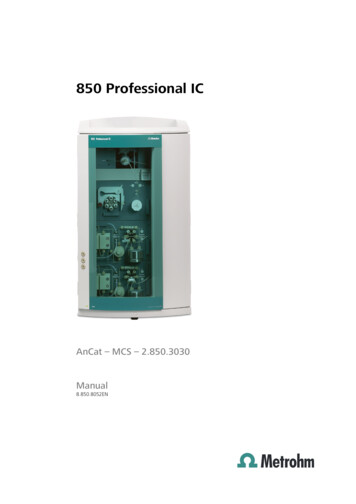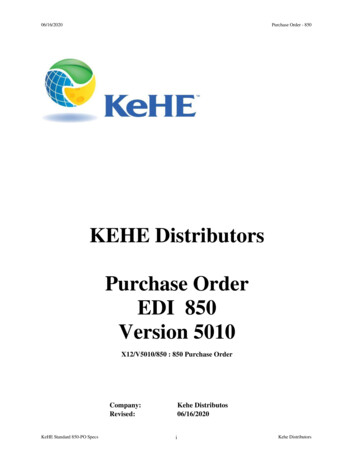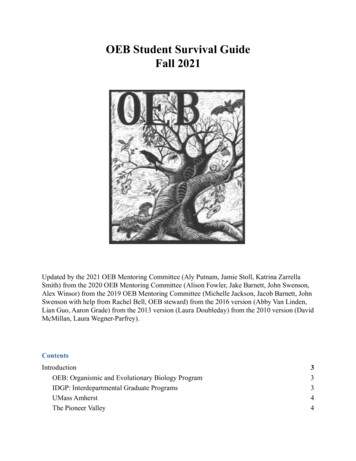
Transcription
850 Professional ICAnCat – MCS – 2.850.3030Manual8.850.8052EN
Metrohm AGCH-9101 HerisauSwitzerlandPhone 41 71 353 85 85Fax 41 71 353 89 01info@metrohm.comwww.metrohm.com850 Professional ICAnCat – MCS – 2.850.3030Manual8.850.8052EN05.2009 zst
TeachwareMetrohm AGCH-9101 Herisauteachware@metrohm.comThis documentation is protected by copyright. All rights reserved.Although all the information given in this documentation has beenchecked with great care, errors cannot be entirely excluded. Should younotice any mistakes please send us your comments using the addressgiven above.Documentation in additional languages can be found onhttp://products.metrohm.com under Literature/Technical documentation.
Table of contentsTable of contents1 Introduction11.1Instrument description . 11.2Intended use . 51.3About the documentation . 51.3.1Symbols and conventions . 51.4Safety instructions . 61.4.1General notes on safety . 61.4.2Electrical safety . 61.4.3Tubing and capillary connections . 71.4.4Flammable solvents and chemicals . 81.4.5Recycling and disposal . 82 Installation92.1About this chapter . 92.2Initial installation . 92.3Flow diagram . 112.4Setting up the instrument . 142.4.1Packaging . 142.4.2Checks . 142.4.3Location . 142.5Capillary connections in the IC system . 142.6Rear of the instrument . 162.6.1Rollers and handle . 162.6.2Positioning and connecting the detector . 192.6.3Transport locking screws . 212.6.4Leak sensor . 212.6.5Drainage tubing . 222.7Capillary and cable feed-throughs . 242.8Eluent . 272.8.1Connecting eluent bottle . 272.9Eluent degasser . 312.10 High pressure pump . 322.10.1 Capillary connections high pressure pump/purge valve . 322.10.2 Deaerating the high pressure pump . 352.11Inline filter . 372.12Pulsation damper . 382.13Sample degasser . 40850 Professional IC – AnCat – MCS III
Table of contents2.14 Injection valve . 412.14.1 Connecting the injection valve . 412.14.2 Mode of operation of the injection valve . 422.14.3 Selecting the sample loop . 432.15Column thermostat . 442.16 Metrohm Suppressor Module (MSM) . 472.16.1 General information on the MSM . 472.16.2 Connecting the MSM . 472.17 Peristaltic pump . 502.17.1 Principle of the peristaltic pump . 502.17.2 Installing the peristaltic pump . 512.18 Metrohm CO2 suppressor (MCS) . 552.18.1 General information on the MCS . 552.18.2 Connecting MCS . 552.18.3 Installing the adsorption cartridges . 562.19Conductivity detector . 582.20 Connecting the instrument . 612.20.1 Connecting the instrument to the PC . 612.20.2 Connecting the instrument to mains supply . 612.21Guard column . 622.22Separation column . 643 Start-up663.1Initial start-up . 663.2Conditioning . 674 Operation and maintenance694.1General information . 694.1.1Care . 694.1.2Maintenance by Metrohm Service . 694.1.3Operation . 704.1.4Shutting down . 704.2Capillary connections . 704.2.1Operation . 704.3Door . 714.4Eluent . 714.4.1Production . 714.4.2Operation . 724.5High pressure pump . 724.5.1Protection . 724.5.2Maintenance . 73IV 850 Professional IC – AnCat – MCS
Table of contents4.6Inline filter . 834.6.1Maintenance . 834.7Inline sample preparation . 854.8Rinsing the sample path . 854.9Sample degasser . 874.9.1Operation . 874.10 Injection valve . 874.10.1 Protection . 874.11 Metrohm Suppressor Module (MSM) . 874.11.1 Protection . 874.11.2 Operation . 874.11.3 Maintenance . 884.12 Peristaltic pump . 934.12.1 Operation . 934.12.2 Maintenance . 944.13 Metrohm CO2 suppressor (MCS) . 964.13.1 Replacing the CO2 adsorption cartridge . 964.13.2 Regenerating the H2O adsorption cartridge . 964.14 Conductivity detector . 974.14.1 Maintenance . 974.15 Separation column . 974.15.1 Separating efficiency . 974.15.2 Protection . 984.15.3 Storage . 984.15.4 Regeneration . 984.16Quality Management and validation with Metrohm . 995 Troubleshooting5.1100Problems and their solutions . 1006 Technical specifications1056.1Reference conditions . 1056.2Instrument . 1056.3Leak sensor . 1056.4Ambient conditions . 1056.5Housing . 1066.6Eluent degasser . 1066.7High pressure pump . 1066.8Sample degasser . 1076.9Injection valve . 107850 Professional IC – AnCat – MCS V
Table of contents6.10Column thermostat . 1086.11Metrohm Suppressor Module (MSM) . 1086.12Peristaltic pump . 1086.13Metrohm CO2 suppressor (MCS) . 1096.14Conductivity measuring system . 1096.15Mains connection . 1106.16Interfaces . 1106.17Safety specification . 1116.18Electromagnetic compatibility (EMC) . 1116.19Weight . 1117 Conformity and warranty7.1Declaration of Conformity . 1127.2Quality Management Principles . 1137.3Warranty (guarantee) . 1148 AccessoriesIndexVI 1121168.1Scope of delivery . 1168.2Optional accessories . 127131850 Professional IC – AnCat – MCS
Table of figuresTable of figuresFigure 1Figure 2Figure 3Figure 4Figure 5Figure 6Figure 7Figure 8Figure 9Figure 10Figure 11Figure 12Figure 13Figure 14Figure 15Figure 16Figure 17Figure 18Figure 19Figure 20Figure 21Figure 22Figure 23Figure 24Figure 25Figure 26Figure 27Figure 28Figure 29Figure 30Figure 31Figure 32Figure 33Figure 34Figure 35Figure 36Figure 37Figure 38Figure 39Figure 40Figure 41Figure 42Figure 43Figure 44Figure 45850 Professional IC – AnCat – MCSFront view of the instrument . 2Flow diagram for a 2-channel system . 12Connection of capillaries with pressure screws . 15Rollers and handle . 17Handle as MPak holder . 18Removable rear panel . 19Connection for the leak sensor on the rear of the instrument . 22Drainage tubing . 23Capillary feed-throughs on the doors . 25Capillary feed-throughs base tray/covering plate . 26Installing eluent bottle attachment . 28Mounting aspiration filter . 28Installing tubing weighting and aspiration filter . 29Eluent aspiration tubing fully equipped. . 29Eluent bottle – connected . 30Eluent degasser . 31Capillary connections high pressure pump/purge valve . 33High pressure pump – Connect inlet . 34Deaerating the high pressure pump . 36Connecting inline filter . 38Pulsation damper – Connection . 39Sample degasser . 40Injection valve – connected . 41Injection valve – Positions . 43Column thermostat . 45MSM – connections . 48Peristaltic pump . 50Installing the pump tubing . 51Install pump tubing connection with filter . 52Install pump tubing connection without filter . 53MCS – connection . 55Adsorption cartridge holder . 57Conductivity detector front . 59Conductivity detector rear . 60Connection detector – MCS . 61Removing piston . 74Components of the piston cartridge . 75Tool for piston seal 6.2617.010 . 76Removing the piston seal . 77Insert the piston seal into the tool . 77Inserting the piston seal into the pump head . 78Removing valves . 79Dismantling valve . 80Components of the inlet valve and outlet valve . 81Changing the filter . 83 VII
Table of figuresFigure 46Figure 47VIII MSM – Components . 90Pump tubing connection – Changing the filter . 95850 Professional IC – AnCat – MCS
1 Introduction1 Introduction1.1Instrument descriptionThe instrument 850 Professional IC – AnCat – MCS (2.850.3030) isone of the model versions of the Professional IC line of instruments manufactured by the Metrohm Company. The Professional IC line of instruments is distinguished by the intelligence of its components, which are able to monitor andoptimize all functions and to provide documentation according to FDArequirements.its compactness.its flexibility. A suitable model version exists for every application.Individual instruments can be converted, expanded or modified to create a different instrument as needed.its transparency. All components are easily accessible and arranged ina clear manner.its safety. Chemicals and electronics are separated and a leak sensor isintegrated in the wet end.its environmental compatibility.low noise emission.The instrument is operated with MagIC Net software. It is connected viaa USB connection to a PC on which MagIC Net is installed. The softwareautomatically recognizes the instrument and checks its functional readiness. MagIC Net controls and monitors the instrument, evaluates themeasured data and administers it in a database. The operation ofMagIC Net is described in the online help or in the tutorial for MagIC Net.850 Professional IC – AnCat – MCS 1
1.1 Instrument description1234567891011121314Figure 11516 17Front view of the instrument1Eluent bottleSee Chapter 2.8.1.2Conductivity detectorsSee Chapter 2.19.3MCSSee Chapter 2.18.4Peristaltic pumpSee Chapter 2.17.2 850 Professional IC – AnCat – MCS
1 Introduction5MSMSee Chapter 2.16.6Injection valveSee Chapter 2.14.7Eluent degasserSee Chapter 2.9.8High pressure pumpSee Chapter 2.10.9Purge valveSee Chapter 2.10.1.10Injection valveSee Chapter 2.14.11Eluent degasserSee Chapter 2.9.12High pressure pumpSee Chapter 2.10.13Purge valveSee Chapter 2.10.1.14Pulsation damperSee Chapter 2.12.15Sample degasserSee Chapter 2.13. Use optional.16Separation columnsSee Chapter 2.22.17Column thermostatSee Chapter 2.15.The instrument contains the following components:Eluent degasserThe eluent degasser removes gas bubbles and dissolved gases from theeluent. For degassing, the eluent flows into a vacuum chamber through aspecial fluoropolymer capillary.High pressure pumpThe intelligent and low pulsation high pressure pump pumps the eluentthrough the system. It is equipped with a chip on which its technical specifications and "life history" (operating hours, service data, . ) are saved.Inline filterInline filters protect the separation column securely against possible contamination from the eluent. Inline filters can however also just as well beused for the purpose of protecting other sensitive components againstcontaminations in the solutions used. The fine 2 µm material of the readilyand easily replaceable filter platelets removes particles such as bacteriaand algae from the solutions.Pulsation damperThe pulsation damper protects the separation column from damagecaused by pressure fluctuations when switching the injection valve, andreduces interfering pulsations during highly sensitive measurements.Sample degasserThe sample degasser removes gas bubbles and disolved gases from thesample. For degassing, the sample flows into a vacuum chamber througha special fluoropolymer capillary.850 Professional IC – AnCat – MCS 3
1.1 Instrument descriptionInjection valveThe injection valve connects the eluent and sample path through rapidand precise valve switchover. A precisely measured amount of samplesolution is injected and rinsed with eluent onto the separation column.Column thermostatThe column thermostat controls the temperature of the column and eluent channel and thus ensures stable measuring conditions. It providesspace for 2 separation columns.Metrohm Suppressor Module (MSM)The MSM is used for chemical suppression during anion analysis. It is pressure-stable, robust and resistant to solvents.Peristaltic pumpThe Peristaltic pump is used for pumping sample and auxiliary solutions. Itcan rotate in both directions.Metrohm CO2 suppressor (MCS)The MCS removes the CO2 from the eluent flow. This reduces the background conductivity, improves the detection sensitivity and minimizes theinjection and carbonate peaks.Conductivity detectorThe conductivity detector continuously measures the conductivity of theliquid passing through and indicates these signals in digital form (DSP –Digital Signal Processing). The conductivity detector exhibits outstandingthermal stability and thus guarantees reproducible measuring conditions.Separation columnThe intelligent separation column is the heart of the ion chromatographicanalysis. It separates the different components corresponding to theirinteractions with the column. The Metrohm analytical columns are equipped with a chip on which their technical specifications and their history(first use / setting up, operating hours, injections, . ) are saved.4 850 Professional IC – AnCat – MCS
1.21 IntroductionIntended useThe 850 Professional IC – AnCat – MCS is used for the ion chromatographic determination of cations and anions. The two channels can beoperated in parallel or completely independently of one another. Sequential suppression can be used in the anion channel: Chemical suppression with the Metrohm Suppressor Module (MSM)(see Chapter 2.16, page 47) and subsequentCO2 suppression with the Metrohm CO2 Suppressor (MCS) (see Chapter 2.18, page 55).The use of sequential suppression reduces background conductivity to aminimum.If required, the instrument can also be used for the determination of cations or anions without suppression.1.3About the documentationCautionPlease read through this documentation carefully before putting theinstrument into operation. The documentation contains informationand warnings which have to be followed by the user in order to ensuresafe operation of the instrument.1.3.1Symbols and conventionsThe following symbols and styles are used in this documentation:Cross-reference to figure legendThe first number refers to the figure number, thesecond to the instrument part in the figure.Instruction stepCarry out these steps in the sequence shown.WarningThis symbol draws attention to a possible life hazardor risk of injury.WarningThis symbol draws attention to a possible hazard dueto electrical current.850 Professional IC – AnCat – MCS 5
1.4 Safety instructionsWarningThis symbol draws attention to a possible hazard dueto heat or hot instrument parts.WarningThis symbol draws attention to a possible biologicalhazard.CautionThis symbol draws attention to a possible damage ofinstruments or instrument parts.NoteThis symbol marks additional information and tips.1.4Safety instructions1.4.1General notes on safetyWarningThis instrument may only be operated in accordance with the specifications in this documentation.This instrument has left the factory in a flawless state in terms of technicalsafety. To maintain this state and ensure non-hazardous operation of theinstrument, the following instructions must be observed carefully.1.4.2Electrical safetyThe electrical safety when working with the instrument is ensured as partof the international standard IEC 61010.WarningOnly personnel qualified by Metrohm are authorized to carry out servicework on electronic components.6 850 Professional IC – AnCat – MCS
1 IntroductionWarningNever open the housing of the instrument. The instrument could bedamaged by this. There is also a risk of serious injury if live componentsare touched.There are no parts inside the housing which can be serviced or replacedby the user.Mains voltageWarningAn incorrect mains voltage can damage the instrument.Only operate this instrument with a mains voltage specified for it (seerear panel of the instrument).Protection against electrostatic chargesWarningElectronic components are sensitive to electrostatic charges and can bedestroyed by discharges.Always pull the mains cable out of the mains connection socket beforeconnecting or disconnecting electrical appliances on the rear panel ofthe instrument.1.4.3Tubing and capillary connectionsCautionLeaks in tubing and capillary connections are a safety risk. Tighten allconnections well by hand. Avoid applying excessive force to tubingconnections. Damaged tubing ends lead to leakage. Appropriate toolscan be used to loosen connections.Check the connections regularly for leakage. If the instrument is usedmainly in unattended operation, then weekly inspections are mandatory.850 Professional IC – AnCat – MCS 7
1.4 Safety instructions1.4.4Flammable solvents and chemicalsWarningAll relevant safety measures are to be observed when working withflammable solvents and chemicals. 1.4.5Set up the instrument in a well-ventilated location (e.g. laboratoryflue).Keep all sources of flame far from the workplace.Clean up spilled fluids and solids immediately.Follow the safety instructions of the chemical manufacturer.Recycling and disposalThis product is covered by European Directive 2002/96/EC, WEEE – Wastefrom Electrical and Electronic Equipment.The correct disposal of your old equipment will help to prevent negativeeffects on the environment and public health.More details about the disposal of your old equipment can be obtainedfrom your local authorities, from waste disposal companies or from yourlocal dealer.8 850 Professional IC – AnCat – MCS
2 Installation2 Installation2.1About this chapterThe Installation chapter contains 2.2a list of all the steps to be carried out during the initial installation (seeChapter 2.2, page 9).a schematic overview of the flow paths (see Chapter 2.3, page 11).a description of the construction, connections and functionality of theinstrument.step-by-step installation instructions. A part of these installation taskshas already been carried out before delivery. They are neverthelessdescribed here in case they need to be carried out once again sometime in the future (e.g. after maintenance of the high pressure pump).Initial installationNoteA large number of the capillary connections are already connected atthe time the instrument is delivered.The following steps still have to be carried out after delivery:NoteEach of the steps numbered 3, 7, 8, 11, 15 and 16 are to be performedfor the anion and cation channels, respectively.1 Setting up the instrument (see Chapter 2.4, page 14).2 Remove handle and rollers (see Chapter 2.6.1, page 16).3 Place the detector in the instrument and connect it (see Chapter2.6.2, page 19).4 Remove transport locking screws (see Chapter 2.6.3, page 21).850 Professional IC – AnCat – MCS 9
2.2 Initial installation5 Connect the leak sensor (see Chapter 2.6.4, page 21).6 Connect drainage tubings (see Chapter 2.6.5, page 22).7 Connect the eluent bottle (see Chapter 2.8.1, page 27).8 Install sample path connections. Connect the sample degasser (if required) (see Chapter 2.13,page 40).Connect sample path connections to the injection valve (seeChapter 2.14.2, page 42).9 Installing the MSM (see Chapter 2.16, page 47) – with associatedperistaltic pump (see Chapter 2.17, page 50).10 Connect the MCS (see Chapter 2.18.2, page 55).11 Connect detector capillaries (see Chapter 2.19, page 58).12 Mains connection (see Chapter 2.20, page 61).13 Connect the instrument to the PC (see Chapter 2.20.1, page 61).14 Initial start-up (see Chapter 3.1, page 66).15 Install the guard column (if used) (see Chapter 2.21, page 62).16 Install the separation column (see Chapter 2.22, page 64).10 850 Professional IC – AnCat – MCS
2.32 InstallationFlow diagramFigure 2 Flow diagram for a 2-channel system shows the flow paths for asystem with one cation channel and one anion channel with applicationof sequential suppression (MSM (2-9) and MCS (2-10)):Anion channelWith the upper high pressure pump (2-3), theMSM (2-9) and the left-hand conductivity detector (2-11).Cation channelWith the lower high pressure pump (2-18) andthe right-hand conductivity detector (2-24).The two channels can be operated in parallel or completely independentlyof one another.The arrangement of the modules in the diagram corresponds to the frontview of the instrument. Liquid containers (eluent bottle, sample vessel,waste container, auxiliary solutions container) and guard column (seeChapter 2.21, page 62) are not shown in the diagram. Which pressurescrews, connections and couplings are used, is described in the installationchapters of the individual modules.850 Professional IC – AnCat – MCS 11
2.3 Flow diagramEluentSampleSample optionalRinsing solutionRegeneration 6281622182019Figure 21Flow diagram for a 2-channel systemEluent inputConnection to the eluent bottle (see Chapter 2.8.1, page 27).12 212Eluent degasserSee Chapter 2.9.850 Professional IC – AnCat – MCS
The instrument 850 Professional IC - AnCat - MCS (2.850.3030) is one of the model versions of the Professional IC line of instruments manu-factured by the Metrohm Company. The Professional IC line of instru-ments is distinguished by the intelligence of its components, which are able to monitor and










